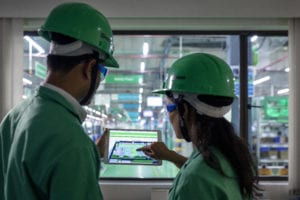Over the last several years, much has been written about the large economic potential of Industry 4.0 and related digitization initiatives. Yet, by most accounts, many digitization efforts have yet to achieve their anticipated benefits. Ironically, the onset of the global COVID 19 pandemic has forced many industrial organizations to accelerate their digital transformation plans in order to both bolster their agility and ensure survival.
Within our own company, Schneider Electric, we have many concrete examples of how digitization is increasing our efficiency and redefining the roles of our workers. Our Smart Factory Program, for instance, has transformed dozens of our manufacturing sites and distribution centers around the world. One of those factories in Batam, Indonesia has recently been recognized by the World Economic Forum (WEF) as a Lighthouse manufacturing site. Lighthouse factories serve as examples of environments that lead the way to a more resilient and inclusive future, where technological innovation can benefit private enterprise, the natural environment, and society at large.
The Batam factory has deployed a wide range of Industrial Internet of Things (IIoT) technologies including smart sensors, alarm prediction management, site benchmarking, and augmented reality to empower its workforce. Workers have a new, advanced visibility into operations, maintenance, and energy use. As a result, maintenance costs have been reduced while overall equipment efficiency (OEE) has increased. The factory has reported a 44 percent reduction in machine downtime over the last year.
Establishing a Digital Transformation Roadmap

When companies from across Asia visit our Batam showcase factory, they have many questions, such as
- “How do I start my journey?”
- “Which of my pain points are easily addressable?”
- “What works well?”
- “Which skill sets do I need?”
- “What about technology?”
For each of our visitors, the answers to these questions will be different, depending on their business challenges. As the digital transformation officer responsible for spearheading the evolution of the Batam site, I’d like to share some of our key learnings so that organizations pursuing digital transformation can avoid false starts and delays and achieve their desired business benefits.
Step 1 – Recognize that Digital Transformation Starts with People
When we began our transformation in 2015, we identified many low value-added manual and administrative activities in our process operations. By 2017 we recognized that we needed not only to modernize technology, but, more importantly, to also leverage digitization to drive people enrichment. Our transformation goals included improved work quality (allowing people to execute their work in a simpler fashion) and the enablement of faster and more accurate decision-making.
Digital transformation is not only about technology adoption. Its more about people and culture change. Upskilling of people and rescaling of processes requires involvement of factory workers at the very beginning of the journey.
But getting the workers on board required a structured and disciplined approach. We primarily used a bottoms-up solution. We talked with operators, maintenance technicians, and engineers one-on-one. Our goal was to not only gather their inputs regarding how to improve workflow, but also to have them come away with the belief that ‘’digital can help make YOUR life easier.” We focus on changing mindsets and breaking down workplace silos to empower shop floor personnel to work smarter and easier.
Creation of an upskilling program is also key. We performed assessments of knowledge levels, identified gaps and, working with the HR department, planned to develop digital literacy and critical thinking skills. By embracing a “this journey is your journey, this transformation is your transformation” philosophy, worker buy-in becomes much easier to manage.
Step 2 – Develop a Broad External Ecosystem with Shared Interests
When we began our digital transformation journey, our implementation team consisted of only four people. We realized that to make digital transformation a reality, we needed to significantly widen our circle of influence. To broaden our ecosystem, we looked to three outside sources: nearby universities, government, and associations like the World Economic Forum. Each of these three outside groups had an important role to play. For instance, in working with local universities, we were able to recruit 12 students to participate in our digital internship program. By bringing a digital mindset to others within our organization, this group of students, eager to work with augmented and virtual reality tools, helped to accelerate the global acceptance of digitization by presenting us with out-of-the-box ideas of how to apply such technologies to our internal processes.
Our efforts to use digitization to reduce waste and energy consumption also dovetailed with the Indonesian government’s Low Carbon Development Initiative. By contributing to the goal of less carbon-intensive, more efficient energy systems, we are helping the government to deliver on its goal of an average of 6 percent GDP growth per year through to 2045—contributing to gains in employment generation, increased incomes, and poverty reduction. This strategy will help cut the country’s greenhouse gas emissions nearly 43 percent by 2030. The government now looks to our factory as a national showcase and actively supports our efforts to drive business growth. Associations like the World Economic Forum also help to validate our efforts and to provide guidance for future improvements.
Step 3 – Apply Technology to Improve Vertical and Horizontal Integration
Many organizations assume that digital transformation occurs in a vacuum, only benefiting those within a particular building or business organization. The true benefits, however, come when efforts are made to link and connect vertically within the organization (e.g., from the machine sensor, to the SCADA system, to the ERP) and also horizontally beyond the organization to external partners such as upstream suppliers and downstream distribution centers.
Regarding horizontal integration, our factory worked with key component suppliers to establish a list of shared product quality parameters for products that were coming into our factory. In this way we were able to avoid duplication of effort in quality control, only having to inspect for quality once instead of twice (assuring quality of the parts before they arrived in our factory). We also linked certain systems so that we could remotely monitor production of the machines that supplied us with parts, seeing up-to-the-minute what the supplier had in stock and how that matched up with our needs.
Assuring Growth During Turbulent Times
In a world that is both unpredictable and changing quickly, leading organizations are accelerating the agility of their operations. Modernization and innovative use of digital tools both provide more certainty and help to position many organizations for long-term, sustainable growth.
For More Information
To learn how your company can establish a plan for platform and people-driven digital collaboration, contact Rik De Smet or Fadli Hamsani, or read our Digital Transformation blog series.
CNN Indonesia published a Digital Transformation article co-authored by Rik and Farid Belbouab, CEO of shipping company Meratus. Read the English version here.



